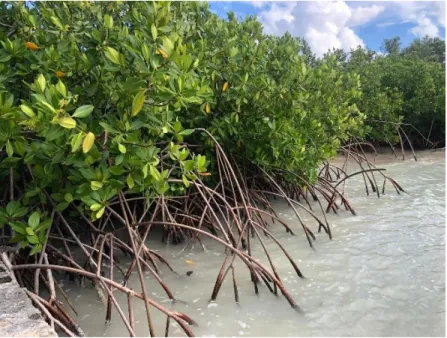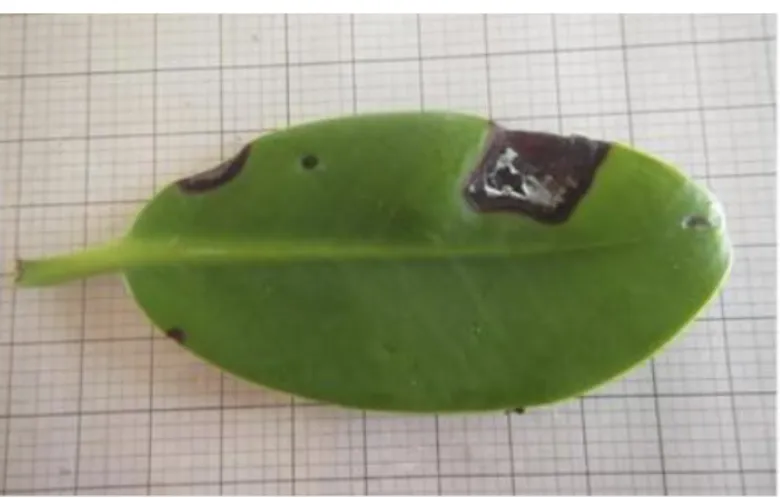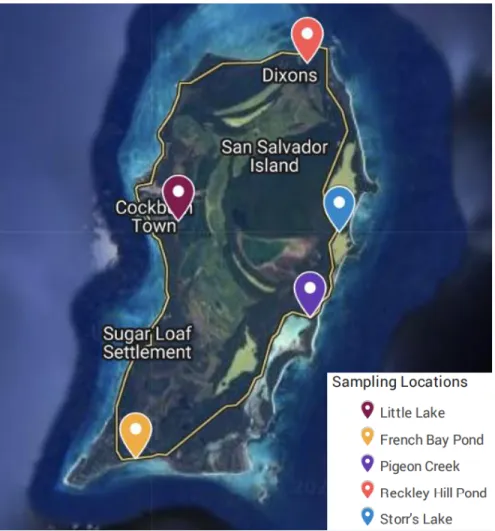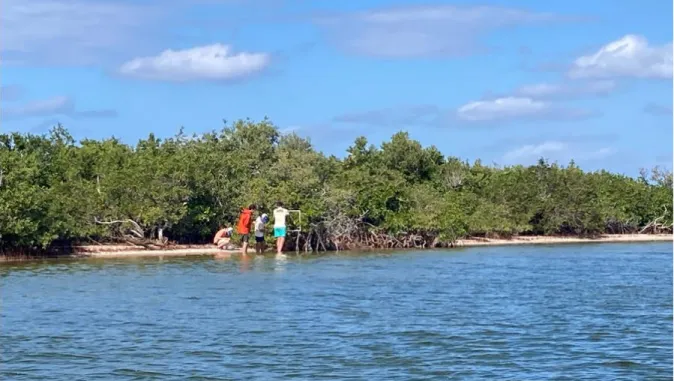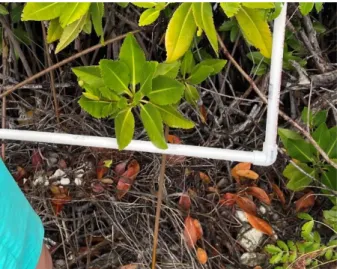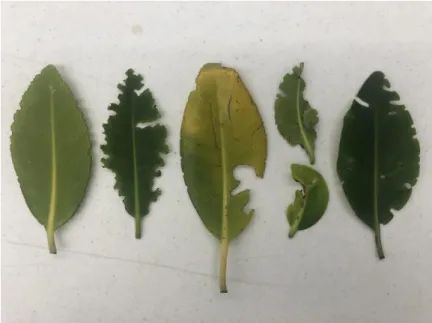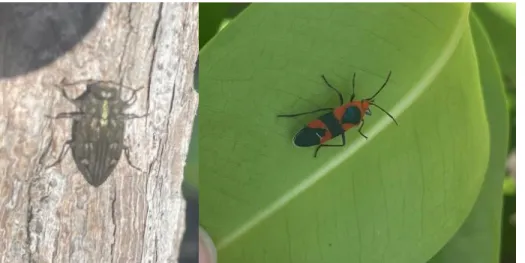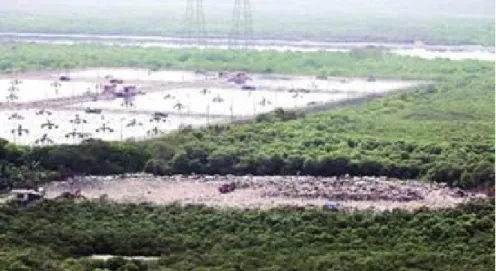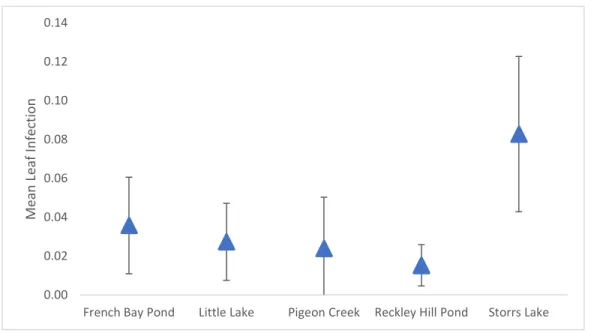A Thesis Presented to The Faculty of Alfred University
A Study of Red Mangrove Health on San Salvador Island Bahamas
by Jessica Henry
In partial Fulfillment Of the requirements for the Alfred University Honors Program
May 2022
Under the Supervision of:
Chair: Dr. Cheryld Emmons Ph.D. Professor of Biology Committee Members:
Nicole Munkwitz Environmental Studies Technician, Justin Grigg Assistant Dean of Graduate Studies
i
Acknowledgements
I would like to start by thanking Dr. D’Angelo for giving me the courage to continue to pursue this thesis even when things looked bleak. Without his guidance, friendly ear, and willingness to act as a sounding board, I would not have been able to see this project through.
I would also like to thank my chair for this thesis Dr. Emmons for her flexibility,
excitement, and willingness to go above and beyond by taking on this project unexpectedly. Her comments, feedback and advising were pivotal in the completion of this thesis and without her encouragement this project would not be where it is today.
Lastly, and most importantly, I would like to thank both my professors and classmates from the Ecology of the Bahamas class. Without all of you I wouldn’t have the excitement or love for this project that I do. And to my fellow classmates and friends in the mangrove group, you helped me with the origin of this project and made this into something I could love and further pursue on my own. Thank you for listening to my project idea on the island and being just as excited about it as I was. Without every one of these people and more this thesis would not have been possible.
ii
Table of Contents
Foreword ... 1
Abstract ... 6
Introduction ... 7
Methods ... 10
Results ... 18
Discussion: ... 23
Works Cited ... 26
1 Foreword
At the beginning of the pandemic, I was hired by the Monroe County Department of Public Health in Western New York State. During the summer of 2021, I was working at a COVID-19 vaccination site when the number of individuals coming in began to decline. With a majority of the residents vaccinated who wanted to be, there was not much work left for us to do.
It was then that we were notified the county was going to begin to shut operations down. Due to this my partner and I decided to take a spontaneous road trip out west to visit the National Parks.
While traveling I fell in love with nature. I was fascinated by the geology, geography, vegetation, and animals that I had never seen before. There was a sense of wonder in traveling and
exploring.
When the Fall 2021 semester started, I knew I still had APEX funding to use and that I wanted to put that towards traveling again. With the threat of Coronavirus still looming there were only two options to go abroad with the university that I was interested in, both of which were scheduled to occur during the same dates. I was stuck between Eurosim, a conference taking place in Swansea Wales, and the Tropical Ecology of the Bahamas class that would be studying on San Salvador Island in the Bahamas. Through a last-minute decision and the greatest stroke of luck I ended up traveling with the Environmental Studies division to the Bahamas to study the local ecology of the island. This trip has proved to be highly influential to my work and passions. It has played a significant role in my transition from career aspirations in public health to conservation and ecology as well as shaping my thesis.
The journey to completing my honors thesis has not gone according to plan. Originally, I had planned to do a thesis regarding Covid-19 data from Monroe County. I had been working
2
with the county for quite some time and I thought this would be the next obvious task. I believed that the topic could tie both my Biology and Political science majors together nicely in one thesis. I had been planning for this project well in advance.
Towards the end of my junior year, I began to experience intense burnout for academics and was losing my passion for learning. During my summer travels I realized that what I really loved was learning from the world around me. Exploring nature and seeking to understand what I saw. I valued the diversity of the organisms I crossed paths with, and grasping the impact that our actions have on these organisms. Coming back from this trip I realized that there was a switch in what I really wanted out of my education and life. Through my fall semester I began the process of coming to terms with the fact that I may not want to pursue a master's degree in Public Health right away. What I really want is to explore the world a bit more, have a better understanding of conservation, and do a variety of short-term positions until I figure out what I would enjoy as a long-term career. But where did this leave my thesis?
About half-way through the spring semester I realized I was stuck. I could no longer look at my original thesis idea without being unmotivated, intimidated, and bored. There was a block there that I thought I could not overcome. Although I had loved my job with the county’s public health department, I had nothing left in me to give to Covid-19 and this included my thesis. I did not care to study the case trends and I no longer enjoyed talking about my ideas or data. After coming to this conclusion and feeling the panic of the clock ticking, I made a meeting with one of my professors. Dr. D’Angelo. While having no major ties to the thesis, he has been an amazing sounding board throughout my college career. I went to him with these pent-up thoughts, feelings, and what I felt was disappointment. Before this conversation I had fully intended on dropping the thesis altogether, but after discussing the issues I was encountering I
3
realized that it was not an issue of completing a thesis altogether. I realized it was actually an issue of passion. I was unwilling to dedicate myself to something I was no longer passionate about. If I could instead center my thesis around something that I cared about, then I had a shot at being able to complete it.
With this in mind I knew the direction I needed to take my thesis. While studying on San Salvador Island the organisms I was the most mesmerized with were the plants. Within the first few days I was so enthralled by the tropical plants that I took out a book on plant identification from the Gerace Research Center library. The next few days I would spend working on
identifying different plants around the island and becoming familiar with those that were the most common. The main plants that continued to catch my attention were the mangrove trees.
Although I didn’t recognize some of the species at first. Our class was tasked with creating group projects that would eventually lead to a research poster. With this goal I knew I wanted to create a topic based on a plant species within the area.
As I was searching online for ideas, I ran across a citizen science survey asking
individuals to look for signs and incidence of disease within mangrove populations. This survey was for the neighboring island of Abaco. This citizen science survey became the inspiration and jumping off point for our project and now my further studies. The survey had individuals record a GPS point of where they collected their sample from, record date and time, take a photo of where they were surveying, record an estimate of the total number of diseased leaves within the area, and collect a healthy leaf, and a diseased leaf. We created a similar methodology for leaf disease incidence findings. Alongside recording the incidence of leaf disease within the mangrove populations, we wanted to further inspect the presence of stressors within the
4
mangrove environment. Our hope was to see if we could find any connection between environmental stressors and the incidence of disease.
San Salvador Island is home to populations of four different species of mangroves including black, red, white, and buttonwood. Our research was based on the red mangrove populations as these were easiest to identify and the same as what was surveyed within the Abaco citizen science survey. With limited supplies on the island, we chose to evaluate factors such as the presence of insects, human disturbance, pH, and crown loss as this seemed feasible within our very limited time frame and tool capabilities.
This research began my studies into mangroves and what this could potentially mean for the mangrove populations of the island. While creating a poster for the project I stumbled on a dissertation from Ryann Rossi, the woman who had created the citizen science survey, and found that the citizen science survey we used was just a small portion of her overall research. Within Rossi’s work she explored the impact of stressors on health, as well as identifying what possible leaf diseases were present. When comparing our work to hers it is evident to see many
similarities and connections between the two. After reaching out and emailing with her, I found many of my remaining questions from our own findings answered, and an even greater interest in the topic. These conversations inspired a few changes in the way I thought about the research we conducted and an intrigued outlook on the future of the mangroves.
Looking back I wish that I had found this topic earlier in our travels as there are many refinements to the process or places to expand on that we did not see in the moment. The difficult part about conducting research while abroad is that there is no easy way to just go back and collect more data, this would be a major feat. If given the chance to do this again I would
5
love an opportunity to enhance this research through a greater number of sampling sites as well as taking more samples at each location. I found that the weakest point within this study is the small sampling size. With more data this research could give a much stronger indication on if there is a correlation between environmental stressors and if so, how strong the correlation may be. Additionally, with the knowledge I have about the subject now I would bring more tools back with me in order to track additional environmental factors.
Lastly the main piece of the project I wish I could go back and reexamine a leaf that was collected from Storr’s lake. One of the leaves collected from this site looks nearly identical to a few of the leaves shown within Rossi’s study. She was able to identify these damaged patches as Pestalotiopsis sp.. Pestalotiopsis is a species of fungus that when she genomically sequenced samples she ended up finding abundantly on the neighboring island of Abaco. I have not found any research indicating that Pestalotiopsis sp. have been previously found or sequenced on San Salvador Island, so this could have been a really interesting place to expand the project.
As I was completing this project I fell in love with the species and enjoyed the work immensely. The process of working collaboratively with students while abroad was a once in a lifetime experience that helped fuel my passion for this health study. The excitement we had for this project while abroad is what has really carried me through in seeing this project to
completion. I hope within this thesis to take the research we conducted on San Salvador, paired with research from neighboring islands, and studies of mangroves globally to attempt to give readers an understanding of what our findings could mean for the future of Red Mangrove populations on San Salvador Island.
6 Abstract
Studies have shown that mangrove populations across the globe are in decline.
Mangrove species are vital organisms within their ecosystems and the success of many other populations can be tied to the presence of mangroves. Mangrove populations are found along shorelines within tropical and sub-tropical brackish bodies of water. Previous research has shown that human disturbance is playing a pivotal role in the decline of mangrove populations. This study identified factors such as abnormal pH, presence of insects, crown loss, and human disturbance as potential stressors. Presence of these factors was recorded at sampling sites to create a mangrove health index. Additionally, leaf counts were taken of healthy and unhealthy leaves to get a measure of the mean incidence of leaf disease per sampling site. A Spearman Correlation was conducted to determine if there was a correlation between the mangrove health index created and the mean incidence of leaf disease. A statistically significant relationship was found between the measure of leaf disease incidence and the mangrove health index created.
7 Introduction
The research presented in this study comes from a health survey of the Red Mangrove trees (Rhizophora mangle) conducted on the island of San Salvador in the Bahamas, inspired by a study on the neighboring island of Abaco as well as global research on mangrove health
(Figure 1); (Rossi 2020, Deegan 2012, Alongi 2002). Mangroves are woody trees and shrubs that grow at the intersection of land and sea (Alongi 2002). The global distribution of mangroves shows a preference for growth within tropical regions with geographic limits set by the presence of 20°C winter seawater (Alongi 2002). Mangrove populations have been separated into the regions of Africa, Asia, Australia and New Zealand, Central American and the Caribbean, Middle East, North America, Pacific, and South America, for global studies (Ward 2016). Asia and Africa hold the largest percentage of global mangrove populations, followed by Central America and the Caribbean (Ward 2016).
Mangrove trees act as the first line of defense for coastal communities within tropical and subtropical climates (Polidoro 2010, Rossi 2020). They provide natural infrastructure and
protection from extreme weather events such as hurricanes. The mangrove root system can absorb harmful nitrates, phosphates, and other pollutants from the water (Birch 2020, Thomas 2017). This improves water quality that flows from rivers and streams to an ocean environment or body of water. They act as nurseries for aquatic populations and are vital to the ecology of estuarine systems and promote biodiversity within their ecosystems (Cross 2011, Sippo 2018).
Due to the vital role that mangroves play within their ecosystems, it is important to track the overall health of mangrove populations.
8
Figure 1. Photo of Rhizophora mangle at Pigeon Creek
Across the globe mangrove recession is being tracked and a global trend of decline has been recorded (Alongi 2002, Rossi 2020, Thomas 2017). From 1980-2005 mangrove dieback was estimated to cover > 3 million ha, with a degradation rate of 1% per year from 1990-2000 (Thomas 2017). Previously noted causes contributing to mangrove loss are extreme and high intensity weather events, climatic extremes, aquaculture, and human deforestation (Sippo 2018, Thomas 2017).
Mangrove species are known for their resilience to high stress environments, such as highly fluctuating salinity, high temperatures, and low soil fertility (Srikanth 2015). Even with their various adaptations to high stress environments, mangrove populations have been in a steady and increasing decline. This has mostly been attributed to human disturbances and development within the ecosystems, but this is not the only factor impacting the populations (Faridah-Hanum 2019). Studies have been conducted to evaluate different categories of mangrove integrity such as, “Mangrove Biotic Integrity Index (MQIS1), Mangrove Soil Index
9
(MQIS2), Marine-Mangrove Index (MQIS3), Mangrove-Hydrology Index (MQIS4) and Mangrove-Socio-economic Index (MQIS5)” (Faridah-Hanum 2019).
Research conducted on the islands of Abaco and Grand Bahama has shown that the presence of the foliar pathogen Pestalotiopsis sp. is common in mangrove die-off areas (Figure 2);(Rossi 2020). This fungus causes leaf spots and petiole blights that damage the plant by killing cells and causing plant stress (Rossi 2020).
Figure 2. Figure from Rossi’s studies in Abaco and Grand Bahama “Common leaf symptoms found in the die-off area”
Studies specific to San Salvador Islandhave noted that the physiognomy of mangrove trees such as short stature, increased yellowing of leaves, and open canopy are signs indicative that the mangrove populations are experiencing high levels of stress (Lugo 1994). San Salvador Island is home to various types of mangroves including red, black, white, and buttonwood mangrove species (Kass 1990). This paper will attempt to explore various factors that may be disturbing mangrove plant health on San Salvador Island. I expect to find a correlation between proportion of leaf infection and the presence of stressors further outlined within a health index.
10 Methods
The research and sampling for San Salvador Island, Bahamas was conducted in January 2022. Red mangrove populations were selected for study as they are the most abundant in number on the island, and easily identifiable. Sampling occurred at Pigeon Creek, Reckley Hill Pond, Little Lake, Storr’s Lake, and French Bay Pond (Figure 3). These sampling sites were selected based on the accessibility by truck. While the study was being conducted portions of the main road, Queen’s Highway, were inaccessible due to major flooding which limited sampling site selection.
The sampling sites selected consisted of red mangrove trees lining inland bodies of water located across different parts of the island. For each of the five sampling sites we drove to a selected inland body of water and located a mangrove patch to use as a starting point. Four trees were sampled per site. To ensure sampling was consistent a measuring tape was used to
determine that at least 50 meters were between each tree sampled. When stopped at the sampling site location, the Pretty Random- RNG app (Version 4.2 Steven Burnett 2016) was used to randomly select a bearing (0-360). This bearing determined which red mangrove would be sampled.
11
Figure 3. Map of San Salvador Island with sampling site locations
A 65 x 65 cm PVC frame was used to perform leaf counts for each tree sampled. The total number of leaves inside the frame were counted and recorded, as well as the number of infected or diseased leaves within the frame (Figure 4). We found the proportion of infected leaves to total leaf count for each sample then calculated the mean and standard deviation for each sample site.
12
Figure 4. Counting damaged and total number of leaves within the 65x65cm PVC frame at Little Lake, San Salvador Island, The Bahamas.
The water pH was recorded for each sampling site. Water pH was measured with the Oakton Waterproof Double Junction pHTestr 3’ (product is discontinued)(Figure 5). Within the study a pH range of 7-8.4 was selected as an acceptable range (Su 2020). The samples taken were recorded and any recorded measure outside of this acceptable range was deemed to be unsuitable for mangrove health.
13
Figure 5. Oakton Waterproof Double Junction pHTestr 3’ probe all the way to the right.
When taking notes on crown loss it was determined that a mangrove sampling site was experiencing crown loss if there were a large number of leaves littering the ground, water, or any nearby area underneath the populations being sampled and accompanied by sparse or barren patches of canopy cover (Figure 6).
Figure 6. Example of crown loss at French Bay Pond. Many red leaves scattering the ground and underbrush.
14
Insect presence at a site was determined both by the physical presence of an insect on either the leaves or branches of the sampling tree, or noticeable signs of insect herbivory to the leaves (Figure 7)(Figure 8).
Figure 7. Examples of the physical presences of insects on mangrove branches (to the left) and insects on mangrove leaves (to the right). Both insects photographed at Storr’s Lake.
Figure 8. Examples of leaves with obvious signs of insect herbivory. Different sizes and shapes of insect bite marks. Leaves came from a variety of sampling sites.
15
A site was classified as experiencing human disturbance if sampling and the population were right up against a major road. Additionally it was classified as human disturbance if the location showed obvious signs of human construction or development (Figure 9).
Figure 9. Example of human disturbance in the form of construction debris being dumped on mangrove population. Photo taken in Mumbai (Bhalerao 2020).
With these measurements we were able to create a mangrove health index that compared in format to previously created indices (Faridah-Hanum, 2019). This index and variables
provided in Tables 1, 2 were used to give a rating to each of our sampling sites. The index ranges with four being in the best condition and zero being the worst. To give a rating each site started out with four points and for each of the listed factors present a point was deducted. A four rating means that the site looked to be in perfect condition, none of the stressors that we were
measuring for were observed and overall, a healthy population was seen. A three rating shows that the mangrove populations at the site were in good condition and only one measured stressor was present, these were overall healthy populations. An index rating of two means that there were two stressors present and the population was in okay condition. These populations showed
16
obvious visual signs of stress. Sites rated as a one were in poor condition with three stressors present. These sampling sites showed obvious visual signs of stress and damage. To receive a 0 rating, all four stressors would need to be present and major damage and or mangrove mortality would need to be seen within the population.
Table 1. Mangrove health index score description.
Table 2. Stressors description for index grading.
17
When back in the United States data analysis was conducted. A normality test was run on the leaf proportions to determine if the data was normally distributed. The purpose of normality tests is to determine if a data set is normally distributed and linear. The null hypothesis for the leaf proportion normality test was that, the data are not different from a normal distribution. If the p-value of a normality test is greater than 0.05 then you fail to reject the null hypothesis, meaning that the data is normally distributed. If the p-value is less than 0.05 for a normality test then the null hypothesis would be rejected meaning that the data would be different from a normal distribution.
After concluding the normality test a pairwise Spearman correlation was conducted between the results from the leaf proportions and the mangrove health index to test for a correlation between the two variables. A Spearman correlation was used because it shows the correlation or association between two variables that are non-parametric, meaning that they are not normally distributed. This type of correlation looks for non-linear relationships.
18 Results
The mean proportion of infection for French Bay Pond was 0.0350 with +/- 0.0249 to account for standard deviation, Little Lake 0.0270 with +/- 0.0198 standard deviation, Pigeon Creek 0.0260 with +/- 0.0263 standard deviation, Reckley Hill Pond 0.0156 +/- 0.0122 standard deviation, and Storr’s Lake 0.0930 +/- 0.0399 (Figures 10, 12-16).
Figure 10. Mean (+/- standard deviation) proportion of leaf infection. This figure shows the overall site mean proportion of leaf infection for each sampling site. The error bars account for the standard deviation calculated for each site.
The health index subtracted one point for each stressor that was present within the population and if the stressor was not seen received a zero. These points were subtracted from the overall score of four At French Bay Pond it was recorded that the pH was 7.1 which is within the acceptable range (Table 2.) so no point was lost. Insect herbivory was present resulting in the
0.00 0.02 0.04 0.06 0.08 0.10 0.12 0.14
French Bay Pond Little Lake Pigeon Creek Reckley Hill Pond Storrs Lake
Mean Leaf Infection
19
loss of a point. Additionally, there was evidence of crown loss with a large number of leaves littering the ground, and lastly site was positioned right on the edge of a road resulting in the reduction of a point for human disturbance. This gave French Bay Pond an indices score of one.
Little Lake had a recorded pH of 7.89 which was within the acceptable range resulting in no points lost. No observations of insects or insect herbivory were noted. Crown loss was present at little lake with many discolored leaves in the water and brush below resulting in the deduction of a point. Human disturbance was also present as two of the samples from this site were taken alongside the road. This resulted in Little Lake receiving a score of two (Table 3).
Pigeon Creek had a recorded pH of 7.7 with is within the acceptable range this resulted in no points lost. There were signs of minor signs of insect herbivory resulting in the subtraction of a point. No crown loss or disturbance were recorded so no points were lost for either category.
This resulted in Pigeon Creek receiving a three within the health index (Table 3).
Reckley Hill Pond had a recorded pH of 7.7 which was within the acceptable range resulting in no points lost. Insect herbivory was present resulting in the loss of a point. There was no obvious crown loss, and the population was well off the main road with no major human disturbances. Neither of these resulted in any points lost, leaving Reckley Hill Pond with an index grading of three (Table 3).
The last site Storr’s Lake had a recorded pH of 7.63 which was within the acceptable limits so no points were deducted. There was limited insect herbivory seen, but two different unidentified insects were present on leaves and branches. Due to the physical presence of insects one point was deducted. There were obvious signs of crown loss resulting in another one-point deduction. This site also had the most significant disturbance. This site had rubble, dirt, and
20
pilings from the road bulldozed on top of them from a nearby construction site. This human disturbance also deducts one point. This leaves the total index grading as a one (Table 3).
Table 3. Mangrove Health Index.
Table includes all of the point deductions for each stressor present and gives each site an index grading score ranging from zero to four. Four is considered the best condition and zero would be the worst condition. A 0 in the field means that the stressor was not present and a -1 in the field means the stressor was present at the sampling site.
After the health index ratings were found, the twenty leaf damage proportions were taken and run through a normality test. The normality test produced a p-value <0.05 so the null
hypothesis was rejected meaning that the data was not normally distributed. Because the data wasn’t normally distributed, a pairwise Spearman correlation was run to test for a non-linear correlation between the leaf damage proportions and the mangrove health index. The Spearman correlation produced a r-value of -0.543 and a p-value of 0.013 (Figure 11).
21 Figure 11. Pairwise Spearman correlation.
The pairwise Spearman correlation produced an r-value of -0.543 and a p-value of 0.013. A p- value less than 0.05 allows for the rejection of the null hypothesis. This shows that there is a statistically significant non-linear correlation between the index grading and the proportion of leaf infection.
Figure 12. French Bay Pond Samples one through four (1-4 pictures ordered from left right)
22
Figure 13. Pigeon Creek Samples one through four (1-4 pictures ordered from left to right)
Figure 14. Little Lake Samples one through four (1-4 pictures ordered from left to right)
Figure 15. Reckley Hill Pond samples one through four (1-4 pictures ordered left to right)
Figure 16. Storr’s Lake samples one through four (1-4 pictures ordered from left to right)
23 Discussion:
With a moderate correlation found between the mangrove health index and the proportion of infected leaves, it leads to the belief that the stressors within the health index do play a role in impacting mangrove health. While the correlation seen was only moderate, it is believed that with a larger sampling size a clearer idea of this connection would be able to be determined.
When comparing our data to a past study done by Rossi on the neighboring island of Abaco, it is interesting to note the similarity in leaf findings. Within Rossi’s work she was able to sequence and Identify Pestalotiopsis sp. as the predominant finding on damaged leaves (Figure 17);(Rossi 2020). Figures taken of our leaves show similar dark brown patches, and when visually inspected had similar white markings over top of the brown (Figure 18). The white patches are hard to see on in Figures presented from San Salvador Island potentially due to poor lighting or camera quality. This similarity and potential for the identification of Pestalotiopsis sp.
on San Salvador Island would be an interesting area to explore for future research, as there are no previous studies indicating the presence of the fungus species on the island.
Figure 17. Figures from Rossi study on Pestalotiopsis sp. on red mangrove leaves. Leaves have large brown spots containing visually white areas on top of the brown (Rossi 2020).
24
Figure 18. Leaves collected from San Salvador Island that contained similar markings to those found in Rossi’s study. Similar large brown markings with patches of white over top. The white patches are difficult to see here due to either poor lighting or camera quality.
It is interesting to note that leaf damage across testing sites was not uniform. Variation included, yellowing to the leaves, speckled leaves, increased rough texture with browning, brown with white patches common of a leaf infected with Pestalotiopsis sp, and many pest related markings. It is important to monitor and isolate what is infecting these trees as the presence of pests in high density can lead to canopy discoloration, leaf damage, defoliation, stem rot, loss of net productivity, and mortality (Jiang 2021). It is suggested that either pests infecting leaves be genomically sequenced or hyperspectral imaging be used in order to earn a greater understanding for next steps of management (Jiang 2021).
The two sites that had the most visually impacted leaves were Storr’s Lake, and Little Lake. Both of these locations were on the east side of the island and directly next to a road.
25
Additionally Storr’s lake had the most obvious signs of human disturbance. The Sampling at Storr’s lake occurred next to a historical renovation site. This resulted in the bulldozing of gravel, mud, and debris right up against the mangrove patches. Storr’s lake had a distinctly higher result for the mean leaf infection. Which leads to a question of how varying degrees of human disturbance may play on mangrove health.
For continued studies within the current research it is suggested that more sampling sites be selected around the island as well as taking more samples per site. It is believed that five sites and four samples per site was just not enough data to get a clear picture on the true significance of each of these stressors on mangrove leaf health. A larger sampling survey would give clearer results and strengthen the understanding of the correlation between the index and leaf health as well as provide an opportunity to look at each factor individually to determine impact on mangrove health.
Lastly it has been identified in previous works that salinity is an important factor in mangrove health (Dharmawan 2021). Many of the factors impacting mangrove health previously noted within research conducted on San Salvador Island point to the pervasive high salinity in both the water and soil as a chronic stressor (Lugo 1994). During testing an Oakton salinity tester was attempted to be used, but the salinity of the water was too high for the probe to read. It is suggested that if further research were to occur a salinity tester be brought that could measure brackish and salt water that way salinity could be another factor added to the mangrove health index.
26 Works Cited
Alongi, D. 2002. Present state and future of the world's mangrove forests. Environmental Conservation, 29(3), 331-349
Bhalerao, S. 2020. Mumbai: 2 Booked for Dumping Construction Debris into Kanjurmarg Creek, Destroying Mangroves. The Indian Express.
https://indianexpress.com/article/cities/mumbai/mumbai-2-booked-for-dumping- construction-debris-into-kanjurmarg-creek-destroying-mangroves-6263357/.
Birch Anne. 2020. Why Are Florida's Mangroves Important?. The Nature Conservancy, https://www.nature.org/en-us/about-us/where-we-work/united-states/florida/stories-in- florida/why-mangroves-important/
Cross R, Cruz-Alvarez M. 2011. Identification of Nuclear DNA Microsatellites from Red Mangrove (Rhizophora Mangle) Populations on San Salvador Island. Gerace Research Center.
Deegan, Linda A., et al. 2012. Coastal eutrophication as a driver of salt marsh loss. Nature, vol.
490, no. 7420, pp. 388-392
Dharmawan EKI. 2021. Mangrove Health Index Distribution on the Restored Post-Tsunami Mangrove Area in Biak Island, Indonesia. Iop C Ser Earth Env. 860 (1):12007 Faridah-Hanum, I., et al. 2019. Development of a Comprehensive Mangrove Quality Index
(MQI) in Matang Mangrove: Assessing Mangrove Ecosystem Health. Ecological Indicators, vol. 102, Elsevier Ltd, pp. 103–17
Fomba SN, Singh N. 1990. Crop losses caused by rice brown spot disease in mangrove swamps of northwestern Sierra Leone. Trop Pest Manage. 36(4):387
Gilbert GS, Mejía-Chang M, Rojas E. 2002. Fungal diversity and plant disease in mangrove forests: salt excretion as a possible defense mechanism. Oecologia. 132(2):278 Holdschlag A, Ratter B. 2013. Multiscale system dynamics of humans and nature in The
Bahamas: perturbation, knowledge, panarchy and resilience. Sustain Sci. 8 (3):407-421 Jiang X, Zhen J, Miao J, Zhao D, Wang J, Jia S. 2021. Assessing mangrove leaf traits under
different pest and disease severity with hyperspectral imaging spectroscopy. Ecol Indic.
129:107901
Kass L, Stephens L. 1990. The Trees of the Mangrove Swamp Community of San Salvador Island, the Bahamas and Their "Succession" Patterns. Gerace Research Center.
Kathiresan, K., and B.L. Bingham. 2001. Biology of Mangroves and Mangrove Ecosystems.
https://www.doc-developpement-durable.org/file/Culture/Arbres-Bois-de-Rapport- Reforestation/mangrove/mangroves.pdf.
27
Lowenfeld R, Klekowski E. 1992. Mangrove Genetics. I. Mating System and Mutation Rates of Rhizophora Mangle in Florida and San Salvador Island, Bahamas. Int J Plant Sci. 153 (3):394
Lugo, E. 1994. San Salvador Mangroves: An Ecosystem Under Chronic Stress. International Institute of Tropical Forestry. Gerace Research Center.
Maharachchikumbura S, Guo L, Chukeatirote E, Bahkali A, Hyde K. 2011. Pestalotiopsis—
morphology, phylogeny, biochemistry and diversity. Fungal divers, 50 (1):167-187 Nguyen HT, Hardy, Hardy G, Le V, Nguyen HQ, Le D, Nguyen T, Dell B. 2021. Mangrove
Dieback and Leaf Disease in Sonneratia apetala and Sonneratia caseolaris in Vietnam.
Forests. 12 (9):1273
Rossi, R ., et al. 2020. “The Role of Multiple Stressors in a Dwarf Red Mangrove (Rhizophora Mangle) Dieback.” Estuarine, Coastal and Shelf Science, vol. 237, Elsevier Ltd, 2020, p.
106660–, https://doi.org/10.1016/j.ecss.2020.106660.
Sippo, Lovelock, C. E., Santos, I. R., Sanders, C. J., & Maher, D. T. 2018. Mangrove mortality in a changing climate: An overview. Estuarine, Coastal and Shelf Science, 215, 241–249 Srikanth, Sandhya, et al. 2015. Mangrove Root: Adaptations and Ecological Importance. Trees,
vol. 30, no. 2, Springer Berlin Heidelberg, pp. 451–65
Su, Chun-Jui, et al. 2020. Salinity, pH and Temperature Growth Ranges of Halophytophthora Isolates Suggest Their Physiological Adaptations to Mangrove Environments.
International Biomechanics, vol.11, no.3, pp.256–62
Ward, Friess, D. A., Day, R. H., & Mackenzie, R. A. 2016. Impacts of climate change on mangrove ecosystems: a region by region overview. Ecosystem Health and Sustainability, 2(4), e01211–. https://doi.org/10.1002/ehs2.1211
